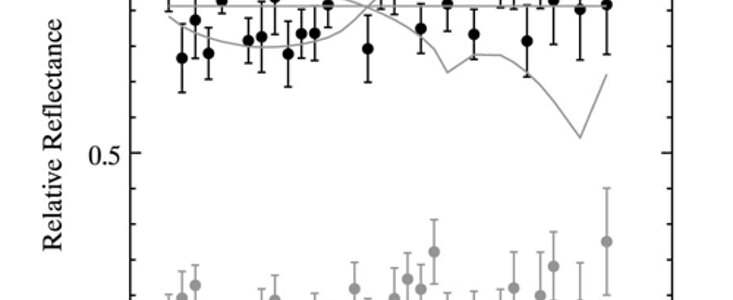Sedna Reveals Pristine Surface in Gemini Near-infrared Spectra
12 April 2005
Recent spectroscopic studies of infrared light reflected from the surface of Sedna reveal that it is probably unlike Pluto and Charon since Sedna's surface does not display evidence for a large amount of either water or methane ice. Due to Sedna’s extreme distance from the Sun, the frigid surface has probably been untouched for millions of years by anything except cosmic rays and solar ultraviolet radiation.
Gemini Observatory astronomer Chad Trujillo led an effort by the same California Institute of Technology research team responsible for Sedna's original discovery to obtain spectra of this distant planetoid using the Near Infrared Imager (NIRI) on Gemini North. Their aim was to better understand the surface of this distant world and how it has evolved since its formation. “It is likely that Sedna has experienced an extremely isolated life in the outskirts of our solar system,” said Trujillo. “Out there beyond what we used to think was the edge of the solar system, interactions or collisions between bodies are probably very rare. Our observations confirm what you would expect from a surface that has been so far out in our solar system for such a long time and exposed to space weathering.”
The Sedna data lack the strong spectral lines that would indicate the existence of substances like methane and water ice, but deeper studies are needed to confirm how low the levels of these ices might be on this planetoid. Sedna might be more like the minor planet Pholus (that lies just inside the orbit of Saturn), which is similar in its redness in visible light. This same “space weathering” may also affect Pluto and Charon, but there may be other processes that replenish their water- and methane-rich surfaces, such as atmospheric effects, geological processes and collisions.
The data could reveal something of Sedna's evolutionary history in the outer solar system. Astronomers think that objects like Sedna start out with icy surfaces. Over time cosmic rays and solar ultraviolet radiation “bake and burn” the surfaces into black hydrocarbon-rich substances similar to asphalt, which do not reveal themselves well in infrared spectra. Such a history might explain why Sedna doesn't exhibit traces of methane and water ice, whereas Pluto and Charon do.
“Like a sandblaster operating for several billion years, most of the objects out as far as Pluto are constantly being resurfaced by impacts and collisions which expose and supply fresh surface materials before the black stuff can get baked on,” said Michael Brown of California Institute of Technology, who is the Principle Investigator of the team that originally discovered Sedna. “Pluto and its moon Charon provide an excellent example of this process, with Pluto displaying a strong methane ice signature in its spectrum and Charon dominated by water ice.”
The team does not rule out the possibility that longer-duration (deeper) observations might reveal evidence of methane or water ice on Sedna. However, the Gemini data indicate that if they do exist their extent is limited.
The results of these observations appeared in The Astrophysical Journal.
Gemini Observations of Sedna
The Gemini observations of Sedna were possible due to the observatory’s powerful ability to collect infrared radiation reflected from the planetoid (which lies over 12 light-hours from Earth). The research team used NIRI (Near Infrared Imager) on Gemini North to obtain the spectra over a period of about two hours on the night of December 27, 2003.
The infrared light captured by Gemini is really “recycled” starlight from the Sun, which at Sedna's distance would appear more like a very bright nighttime star. Just as some of the sunlight striking this object is reflected back as optical light (which allowed its discovery), some of the infrared light is also reflected back. Materials on the surface imprint a characteristic fingerprint on the re-emitted light, which can reveal details about the composition of the planetoid’s surface.




